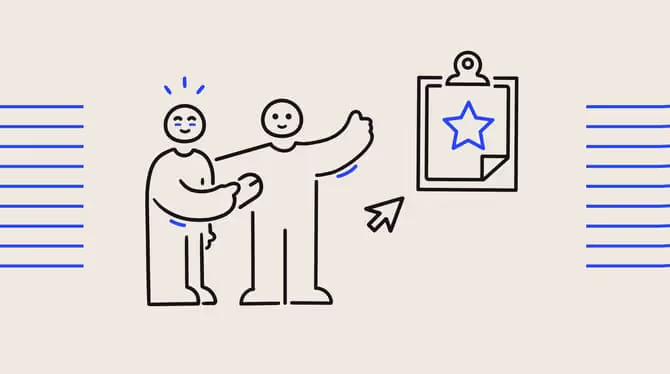Understanding performance review cycles

Discover Workleap Officevibe's benchmark report on 12 key employee engagement metrics

In the world of employee performance management, the review cycle stands as a fundamental process. It's the machinery behind setting expectations, evaluating achievements, and fostering professional growth.
Here, we demystify the performance review cycle, its significance within performance management, and how it can revolutionize employee performance. Whether you're an HR manager or a team leader, understanding the ins and outs of this essential system is vital for driving your team's success.
What is a performance review cycle?
A performance review cycle, also known as a performance appraisal cycle or performance management cycle, sets structured timelines during which an employee's work performance is evaluated.
Performance management cycles can vary in length, but it's important to note that strategies are most effective when played out on a continuous basis. Within these cycles, employees receive feedback about their accomplishments, strengths, and areas that need improvement. The process is comprehensive, encompassing goal setting, performance monitoring, development plans, and a final evaluation.
Having a well-defined performance management cycle plan ensures everyone is on the same page, driving growth and alignment in your organization.
The importance and benefits of the performance cycle
Our definition of the performance management cycle extends beyond corporate responsibilities, encompassing a vital process that fosters alignment between employees and management in pursuit of shared goals, a critical element for the success of any organization.
What are the benefits of such performance management cycles? They include:
- Feedback and improvement: The cycle provides employees with constructive feedback, highlighting strengths and areas for improvement. This feedback is crucial for personal and professional growth, helping individuals understand their performance relative to expectations and setting clear goals for development.
- Goal alignment: Performance reviews help align employees' goals with the organization's objectives. By discussing performance in relation to company goals, employees can better understand their role in achieving the company's mission, fostering a sense of purpose and motivation.
- Recognition and accountability: Regular performance reviews recognize and reward strong performance, ideas, and efforts while holding individuals accountable for their responsibilities. This promotes a fair and transparent work culture, as well as employee engagement, motivating everyone to excel and contribute to the organization's overall success.
A well-structured performance management cycle model transforms the workplace into a fertile ground for business success, nurturing employee growth and aligning it with company objectives.
The stages of the performance management cycle
The performance management cycle is a vital component in the development, alignment, and growth of employees and the organization.
Here's the crux: a well-structured performance management cycle acts as the bridge between an employee's daily tasks and the grand vision of the organization. It's the mechanism that ensures that employees' efforts harmonize with the strategic objectives of the organization. Lets navigate through the performance management cycle, where each step serves as a vital link, aligning employees' daily tasks with the overarching vision of the organization.
The planning stage
In the planning stage of the performance management cycle, managers and employees collaborate to set clear goals, expectations, and development plans for the upcoming review period. This phase is where the foundation is laid, creating a roadmap for the employee's performance journey that aligns with the company's objectives and the employee's job responsibilities.
{emphasize}
Imagine a marketing specialist meeting with their manager to set goals for the upcoming quarter. During this discussion, they decide that the specialist will increase website traffic by 15% and generate 20% more leads through content marketing.
{emphasize}
Use conversations, not evaluations, to give feedback
It's essential to shift the focus from one-sided evaluations to two-way conversations during the performance management cycle. Evaluations might tell you what needs improvement, but conversations tell you how to make those improvements.
Engaging in meaningful discussions allows for better understanding, motivation, and collaboration between managers and employees. Clue into these tips from managers for better one-on-one meetings.
From HR-led process to employee-led framework
Historically, performance management systems were often led by HR departments. Today, the trend is shifting toward more employee-led frameworks. This change empowers employees to take ownership of their performance, fostering accountability and motivation.
Transform your performance management cycle into a collaborative employee-driven framework. Read about the peer feedback loop.
The monitoring stage
Progress is tracked in the monitoring stage, and the employee's performance is observed throughout the review period. Managers schedule regular check-ins with employees to ensure that their performance is on track and aligned with these predefined objectives. These meetings provide opportunities for open discussions about progress and challenges, offering a chance to correct course as needed.
{emphasize}
During weekly check-ins, the marketing specialist updates their manager on the results of the latest content campaign. They discuss the rising website traffic and lead generation metrics, noting that they're on track to meet their new quarterly target of 20%.
{emphasize}
The developing and reviewing stage
In the developing and reviewing stage,employees and managers assess the progress made. This phase provides an opportunity to reflect on achievements, review performance metrics, and identify areas that require further development. These reviews are collaborative, with employees sharing their accomplishments and challenges.
At the end of the quarter, the marketing specialist and their manager have a comprehensive review. They analyze the quarterly data, discussing achievements like surpassing the website traffic target and gaining valuable insights into what didn't work. They also outline employee performance plans for the next performance cycle, addressing the need for additional training in SEO to further enhance website traffic.
The rewarding stage
The rewarding stage isn't merely about financial incentives. It's a time to acknowledge and celebrate employees' achievements. Recognizing their efforts and contributions reinforces positive behaviors and motivates them for future success. This can be done in a variety of ways — from a simple "thank you" to more public recognition, or a lengthier private message.
During the performance review process, the marketing specialist's manager takes the time to acknowledge their hard work and the results they achieved. This recognition serves as positive reinforcement, motivating the specialist to continue producing top-notch work in the next quarter.
Performance management cycle roles and responsibilities for managers and employees
A typical performance management cycle involves an employee and their direct reports, usually line managers. To ensure the performance management cycle functions at its best, it's imperative to understand who does what and why.
Managers:
- Supervise the review cycle: Managers take on a leadership role in overseeing the performance review cycle. They facilitate the entire process, ensuring it runs smoothly and effectively.
- Provide guidance and continuous feedback: One of the core functions of managers is to provide consistent, actionable feedback to employees throughout the cycle. This includes regular check-ins, constructive criticism, and recognition of achievements.
- Support employee development: Managers should actively encourage employee development by identifying skill gaps and providing resources, training, or opportunities for growth. They are instrumental in helping employees reach their goals.
- Set performance expectations: Managers establish clear performance expectations at the beginning of the performance management cycle. These expectations should be SMART (Specific, Measurable, Achievable, Relevant, and Time-bound) and align with organizational goals. Managers must continuously communicate these expectations.
Employees:
- Actively engage in the cycle: Employees should actively participate in the performance management cycle. This means embracing the goal-setting process, attending regular check-ins, and addressing performance concerns.
- Participate in setting goals: During the planning phase, employees should work closely with their managers to set clear, achievable goals that support both personal development and the organization's mission. These goals are the basis for their performance evaluation.
- Monitor their own performance: Employees have a responsibility to monitor their own performance and ensure they are on track to meet their goals. Regular self-assessment helps identify areas for improvement.
- Seek out development opportunities: Actively seeking opportunities for growth and skill development is a key employee responsibility. Employees should communicate their development needs to their managers and take advantage of available resources.
- Collaborate with managers: Collaboration is crucial. Employees should maintain open and transparent communication with their managers. Discussing challenges, seeking guidance, and sharing achievements helps maintain alignment with performance expectations.
This collaborative effort between managers and employees ensures that the performance management cycle is not a one-sided process but an engaging and interactive experience that promotes growth and achievement.
Everyday performance: How frequent feedback creates high-performing employees
Frequent feedback is essential to improve employee performance. Unlike traditional annual reviews, which can be overwhelming, everyday feedback keeps employees on track and aligned with their goals.
Daily feedback keeps the channels of communication wide open, allowing for immediate course corrections. Whether it's a quick acknowledgment of a job well done or a gentle nudge in the right direction, these regular exchanges play a pivotal role in enhancing overall performance.
Feedback needs to be light-touch but high in frequency
A light-touch approach emphasizes quick, relevant feedback that can be incorporated into daily work. Providing feedback frequently ensures that employees are always aware of their performance status. Think of yourself as a seasoned coach providing subtle, timely guidance throughout a game rather than a single, exhaustive halftime pep talk.
Rules of the game for frequent, light-touch feedback:
- Brief but meaningful
- Doesn't need to be planned — delivered on the fly
- Typically informal and unstructured
- Focuses on specific, immediate performance
- Commonly occurs in day-to-day interactions
- Aims to guide and correct actions in real-time
In short, it's not about heavy, formal feedback sessions — it's about daily or frequent actionable conversations. Something that can be expressed in passing and easy to digest by an employee, appropriate to share while waiting around the coffee machine:
"Hey Anna, thanks for sending over the deck. Since we only use PDFs for presentations, can you resend in the correct format and make sure to do this for all future decks? Catch you later!"
Regular 1-on-1 meetings between manager and employee
Regular one-on-one meetings provide a platform for open communication, where managers and employees can discuss performance, address concerns, and set future goals. These weekly, bi-weekly, or monthly meetings are the cornerstone of transparent and ongoing feedback, where expectations and achievements can be aligned.
The basics to remember for one-on-ones:
- Require more time and planning
- Formal and structured discussions
- More comprehensive, covering broader performance areas
- Occur at set intervals (e.g., weekly, monthly, annually)
- Provide a platform for open dialogue and goal-setting
- Offer a deeper analysis of performance and development goals
- Set the next steps on performance and a follow-up plan
One-on-ones are where employees can refuel their motivation and realign their efforts for the bigger picture. They help boost the side of the performance management process that examines long-term success.
What should you cover during a progress check-in?
A progress check-in is not just about touching base with employees. It’s about ensuring that they are on the right path to meet their goals, which is par for the course in effective performance management.
Here are some key areas to cover during these conversations:
- Goal review: Begin by revisiting the objectives set during the planning process. Discuss the progress made, any obstacles faced, and potential adjustments to the goals if necessary.
- Performance metrics: Analyze relevant data and metrics to assess how an employee is tracking toward their goals. Is the performance improving, and if not, what could be contributing to the stagnation?
- Strengths and areas for improvement: Encourage employees to self-reflect on their performance. What areas do they believe they excel in, and where do they feel they need improvement? This self-awareness can guide development efforts.
- Feedback exchange: It's a two-way street. Provide constructive feedback on what's going well and areas that need improvement. Encourage employees to share their feedback on the resources, tools, or support they need to perform at their best.
- Professional development: Discuss future development opportunities like training, skill development, or mentorship that can enhance an employee's capabilities and contribute to their career progression.
- Alignment with company goals: Ensure that an employee's goals remain aligned with the broader company objectives. It's crucial for the entire team to move cohesively towards the same mission.
Remember, these conversations are meant to be open, collaborative, and forward-looking. They are an opportunity to recognize accomplishments, identify areas for growth, and align individual and organizational aspirations.
Goal-setting is critical for a best-practice performance management cycle
Goal-setting is a cornerstone of a robust performance management cycle. When employees have clear, specific, and achievable objectives, they know what's expected of them and how they contribute to the organization's success.
{emphasize}
Pro tip: When setting employee goals, consider using the SMART criteria.
{emphasize}
Goal-setting is critical because itprovides clarity and motivation. Goals become the steps of a staircase to success, breaking down what needs to be achieved by employees, and reducing ambiguity and misunderstandings. Clarity then drives motivation as employees see the direct link between their efforts and the outcomes — so much easier to march confidently forward when the path ahead is visible!
The SMART system makes employee goals more actionable and effective — and because they're measurable and specific, they identify benchmarks too. It then becomes much easier to evaluate performance when there are well-defined benchmarks and provide relevant feedback.
Feedback is what binds all the elements of performance management together. It provides an understanding of what's been done, and what are the areas for improvement and learning. This feeds into the development aspect, which helps set new goals to keep on target towards success but with the necessary course correction for an employee to get there.
And so, the performance management cycle loop is complete.
Embrace the power of review cycles to master the performance management process
A well-implemented performance management cycle can empower organizations to maximize potential and drive employee success. By understanding the various stages of the performance cycle, adopting a culture of continuous conversations, and setting clear objectives, managers and employees can work together to enhance performance and achieve both individual and organizational goals.
However, it's important to remember that a one-size-fits-all approach won't work for every organization. Effective performance management needs to be tailored to an organization's unique culture, values, and objectives. Keep the human element at the forefront, and ensure that performance management is not merely a process but a way to nurture, develop, and motivate your workforce.
Investing in a performance management cycle is an investment in your people, your company, and your future success. Why not start enhancing performance today?
Give HR and managers the clarity, confidence, and connection to lead better every day.


%20(1).png)


.png)
.png)








